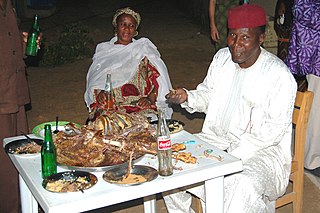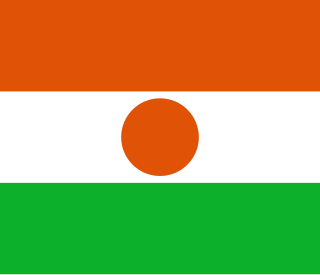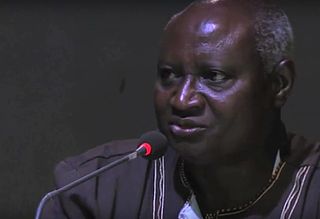A list of notable buildings and structures in Niger:
A list of notable buildings and structures in Niger:

Niamey is the capital and largest city of Niger. Niamey lies on the Niger River, primarily situated on the east bank. Niamey's population was counted as 1,026,848 as of the 2012 census. As of 2017, population projections show the capital district growing at a slower rate than the country as a whole, which has the world's highest fertility rate. The city is located in a pearl millet growing region, while manufacturing industries include bricks, ceramic goods, cement, and weaving.

Zinder, formerly also spelled Sinder, is the third largest city in Niger, with a population of 235,605 as by the 2012 census. It is situated 861 km (535 mi) east of the capital Niamey and 240 km (150 mi) north of the Nigerian city of Kano.

Agadez, formerly spelled Agadès, is the fifth largest city in Niger, with a population of 110,497 based on the 2012 census. The capital of the eponymous Agadez Region, the city lies in the Sahara desert, and is also the capital of Aïr, one of the traditional Tuareg–Berber federations. The historic centre of the town has been designated a World Heritage Site by UNESCO.

Maradi is the second largest city in Niger and the administrative centre of Maradi Region. It is also the seat of the Maradi Department and an Urban Commune.

Stade Général Seyni Kountché (SGSK) is a multi-purpose stadium in Niamey, Niger. Used for football matches, it is home to the Niger national football team, as well as Niger Premier League clubs Sahel SC, Olympic FC de Niamey, Zumunta AC and JS du Ténéré, as well as club competitions such as the Niger Cup. The venue is also sometimes used for rugby union. It is the largest stadium in Niamey, followed by the 10,000-capacity Stade municipal.

The government and people of Niger observe twelve official public holidays. These include international commemorations, the commemoration of important dates in the history of Niger, and religious holidays. Both Christian and Muslim holidays are observed as official public holidays.
Say (Saayi) is a town in southwest Niger, situated on the Niger River. It is the capital of the Say Department in the Tillabéri Region. Say was a small Songhai town prior to the arrival of the Fulani marabout Alfa Mohamed Diobo in the nineteenth century who converted the town to a center for Islamic learning and established the Emirate of Say. The municipality has 58,290 inhabitants, and its economy is dominated by agriculture, herding and small trade. Today, the inhabitants of Say are mostly Peulh, Songhai and Zarma.

Abdou Moumouni University, formerly the University of Niamey from 1974 to 1994, is a public university based in Niamey, the capital of Niger. The main campus is situated on the right bank of the Niger River. Historically, its students and faculty have been involved in protest movements in the capital.

The following outline is provided as an overview of and topical guide to Niger:

The Grand Mosque of Niamey is an Islamic mosque located in Niamey, Niger. It was built in the 1970s. The largest mosque in the city, it is located along Islam Avenue. The building was funded with money from Libya. It features a minaret with 171 steps from top to bottom.

Hamdallaye is a village and rural commune in Niger. In 2012, it had a registered population of 57,002 inhabitants. It is located in the southwest of the country, near the Niger River, the border with Mali and Burkina Faso and the national capital, Niamey. It is the location of a U.S. Peace Corps training site, a weekly market and a mosque.

Harikanassou is a large village and rural commune in the Boboye Department of the Dosso Region of southwest Niger, 90.7 kilometres (56.4 mi) by road southeast of the capital of Niamey. At the time of the 2012 census, the rural community had 23,567 residents living in 3,340 households. Onion cultivation is a chief source of income for many, along with the cultivation of lettuce, beans, squashes, and tomatoes.

Adamou Idé is a Nigerien poet and novelist.

The National Hospital is a hospital in Niamey, Niger. It has 244 beds. The hospital was founded in 1922.
Lamordé University Hospital or Lamordé National Hospital is a teaching hospital in Niamey, Niger. Affiliated with Abdou Moumouni University, the facility has 72 beds. It was the first public hospital in Niger to provide fistula repair services.
Mariama Hima Yankori is a Nigerien film director, ethnologist and politician. She became the first female Nigerien film director in the 1980s, was State Secretary of Promotion of Women and Protection of Children, and later the first female Nigerien ambassador to France.
The following is a timeline of the history of the city of Niamey, Niger.